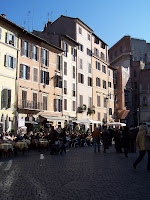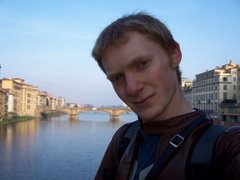 vendors selling fruit and vegetables
vendors selling fruit and vegetables and 60 degree temperatures
and 60 degree temperatures and not two feet of snow like in DC.
and not two feet of snow like in DC.In addition to working on our studio projects and going to Italian class, our history class started last week. So far it seems like it will be amazing. The first day was spent trekking through the Roman Forum, learning about its importance as a symbol, as a meeting place, and as a tool of expansion for the Roman Empire. It was incredible, even the ruins are impressive, but the whole complex must have been truly amazing.

During yesterday's history class we hiked around our neighborhood, once known as the Campus Martius. The ancient layout of the city can still be seen in Rome's centro storico because the buildings that are currently standing used the foundations of the huge ancient buildings that once stood here to build upon. We learned that our studio, Palazzo Pio, stands on what was once the Theater of Pompey, built in the 1st century B.C. They have done studies of the walls of our building and found that the cores of some of the walls are actually the original walls from the complex that stood here... over two thousand years ago. Apparently when we climb the stairs to our studio, we're climbing past what was once a temple to Venus. Crazy, right?
Last week, we crossed the Tiber to visit Santa Maria in Trastevere as one of the sites for our studio project. Every church I've seen is beautiful in a unique way and this one had a coffered gold leaf ceiling that was absolutely amazing. It also had a huge piazza and a pretty big octagonal (spitting) fountain that had a lot of room for people to sit and sketch on.
 Santa Maria in Trastevere and its piazza.
Santa Maria in Trastevere and its piazza. The row of expressive statues above the entrance.
The row of expressive statues above the entrance. Two of the statues and the belltower.
Two of the statues and the belltower. Candles in a side aisle.
Candles in a side aisle. One of the beautiful chapels on the left side of the church.
One of the beautiful chapels on the left side of the church.

Anyway, sorry for the rambling nature of this post. We're leaving for southern Italy on Thursday for about a week and a half, so hopefully we'll have some awesome pictures and things to tell when we get back.



































